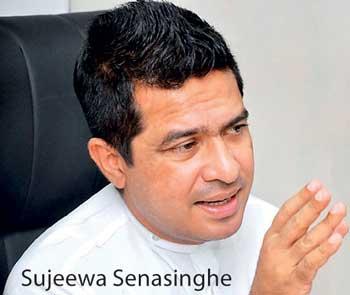12 Apr 2019 - {{hitsCtrl.values.hits}}
 By Nishel Fernando
By Nishel Fernando
The Ministry of Science, Technology and Research is to kick off a four-year National Entrepreneurship and Innovation Strategy in Kuliyapitiya this June, with the objective of increasing high tech exports to US$5 billion by 2024.
The Cabinet of Ministers last month approved the National Entrepreneurship and Innovation Strategy.
The key objectives of the strategy are supporting SMEs to develop higher value-added products and services for exports, building the ecosystem for scaling growth-oriented start-ups and modernizing and re-aligning the R&D sector.
Speaking to Mirror Business, Non Cabinet Minister for Science, Technology and Research Sujeewa Senasinghe revealed that with the implementation of the strategy, the export revenue from science and technology will increase to US$ 5 billion from the current US$ 1 billion.
He noted that the government is planning to provide necessary support for innovators and entrepreneurs to come up with 500 new inventions during the period.
The government plans to offer entrepreneurial packages for entrepreneurs to develop their ideas into new innovation, while supporting them to build up their supply chains and quality standards.
“The entrepreneurs would be given training on how to manufacture something, whom to sell, where to export and so on. We will walk them through the whole process. From household based self employer to large scale manufacturer, we can provide insights on how to get into exports,”
Senasinghe said.
The minister said that he has secured the support of over 500 private sector companies for the strategy, to donate machinery and capital goods.
Sri Lanka’s manufacturing continues to be highly labour-intensive, while skill and capital-intensive exports remain low compared to regional peers. The strategy proposed an increase of Gross R&D expenditures (GERD) to approximately 0.8 percent of GDP, while at the same time incentivizing private sector R&D expenditures to reach over 50 percent of total expenditures.
The strategy also identified the need for cultural transformation across society, as Sri Lankans have a somewhat pessimistic perception on innovation and entrepreneurship.
Further, better coordination of all actors, increased collaboration and trust between the public and private sector, a sustained long-term financial, institutional, and political commitment have also been identified as crucial factors to boost high tech exports, to become a knowledge-based economy.
The Ministry of Science, Technology and Research holds awareness sessions, trade exhibitions and B2B sessions in each district creating a platform for investors, entrepreneurs, public servants, knowledge partners, university students, school children and the general public.
According to Senasinghe, these events will be held for 4 days in each district starting from in the Kurunegala district this June, followed by Colombo, Jaffna, Matara, Kandy and Anuradhapura districts. He noted that this would be also an opportunity for start-ups to find potential investors and supplies to grow their businesses. The trade stalls at the exhibition is expected to offer an opportunity for entrepreneurs and innovators to buy necessary machinery and goods at a 25 percent discount.
Senasinghe said the strategy is divided into twelve themes and different State institutions will be in-charge of them while Science, Technology, Engineering, and Mathematics (STEM) will be a core theme in all of them.
He also plans to get universities involved in implementing the strategy.
The Ministry of Science, Technology and Research also plans to hold job fairs in each district and facilitate partnerships between private sector firms and vocational training centres to develop required skills for the high-tech driven exports.
15 Nov 2024 50 minute ago
15 Nov 2024 3 hours ago
15 Nov 2024 3 hours ago
15 Nov 2024 3 hours ago
15 Nov 2024 3 hours ago